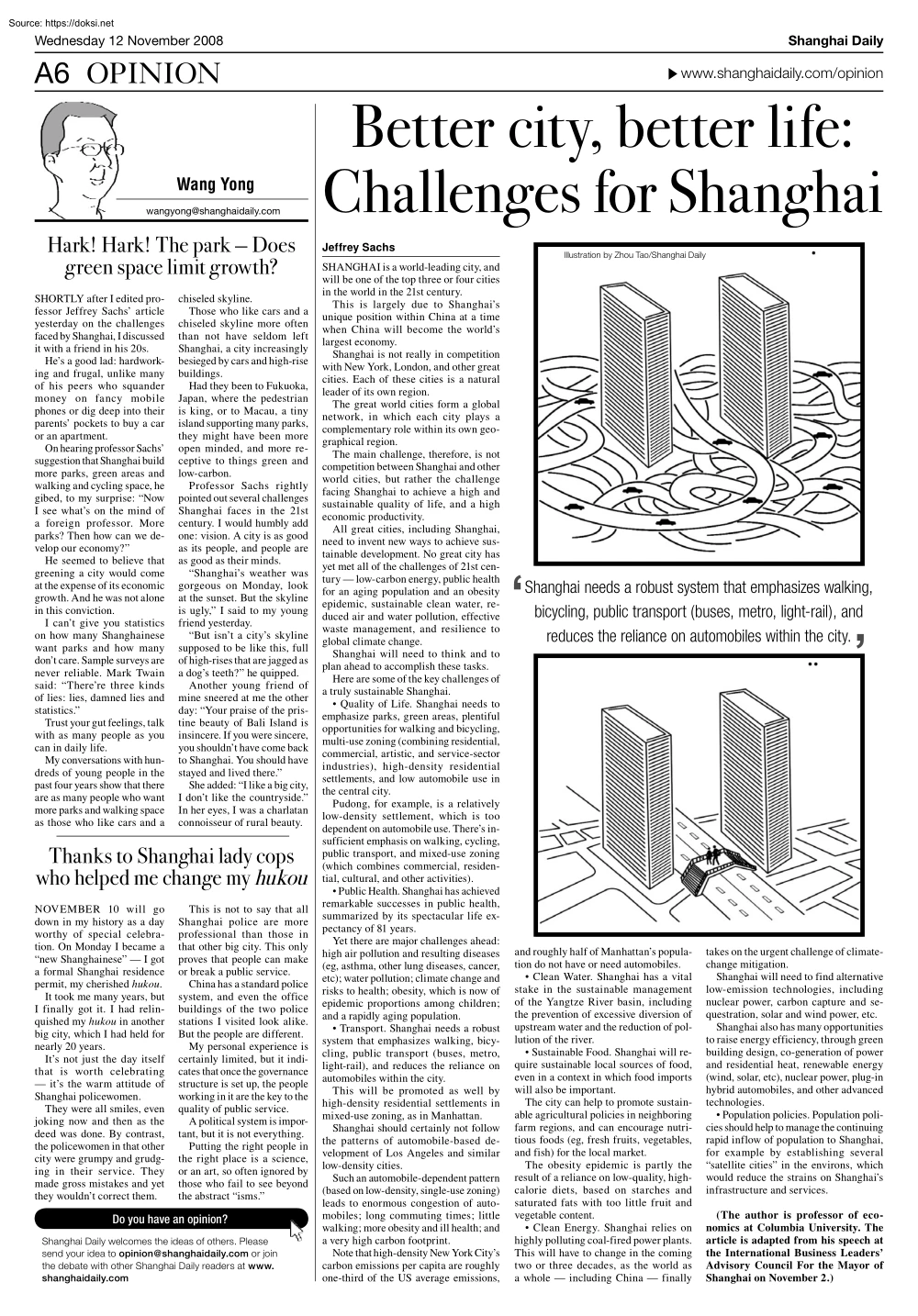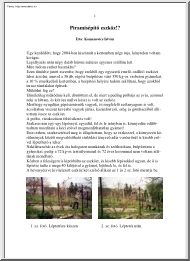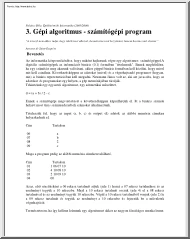Datasheet
Year, pagecount:2008, 1 page(s)
Language:English
Downloads:3
Uploaded:May 22, 2023
Size:1 MB
Institution:
-
Comments:
shanghaidaily.com
Attachment:-
Download in PDF:Please log in!
Comments
No comments yet. You can be the first!Most popular documents in this category
Content extract
Wednesday 12 November 2008 Shanghai Daily A6 OPINION www.shanghaidailycom/opinion Wang Yong wangyong@shanghaidaily.com Hark! Hark! The park Does green space limit growth? SHORTLY after I edited professor Jeffrey Sachs’ article yesterday on the challenges faced by Shanghai, I discussed it with a friend in his 20s. He’s a good lad: hardworking and frugal, unlike many of his peers who squander money on fancy mobile phones or dig deep into their parents’ pockets to buy a car or an apartment. On hearing professor Sachs’ suggestion that Shanghai build more parks, green areas and walking and cycling space, he gibed, to my surprise: “Now I see what’s on the mind of a foreign professor. More parks? Then how can we develop our economy?” He seemed to believe that greening a city would come at the expense of its economic growth. And he was not alone in this conviction. I can’t give you statistics on how many Shanghainese want parks and how many don’t care. Sample surveys
are never reliable. Mark Twain said: “There’re three kinds of lies: lies, damned lies and statistics.” Trust your gut feelings, talk with as many people as you can in daily life. My conversations with hundreds of young people in the past four years show that there are as many people who want more parks and walking space as those who like cars and a chiseled skyline. Those who like cars and a chiseled skyline more often than not have seldom left Shanghai, a city increasingly besieged by cars and high-rise buildings. Had they been to Fukuoka, Japan, where the pedestrian is king, or to Macau, a tiny island supporting many parks, they might have been more open minded, and more receptive to things green and low-carbon. Professor Sachs rightly pointed out several challenges Shanghai faces in the 21st century. I would humbly add one: vision. A city is as good as its people, and people are as good as their minds. “Shanghai’s weather was gorgeous on Monday, look at the sunset. But
the skyline is ugly,” I said to my young friend yesterday. “But isn’t a city’s skyline supposed to be like this, full of high-rises that are jagged as a dog’s teeth?” he quipped. Another young friend of mine sneered at me the other day: “Your praise of the pristine beauty of Bali Island is insincere. If you were sincere, you shouldn’t have come back to Shanghai. You should have stayed and lived there.” She added: “I like a big city, I don’t like the countryside.” In her eyes, I was a charlatan connoisseur of rural beauty. Thanks to Shanghai lady cops who helped me change my hukou NOVEMBER 10 will go down in my history as a day worthy of special celebration. On Monday I became a “new Shanghainese” I got a formal Shanghai residence permit, my cherished hukou. It took me many years, but I finally got it. I had relinquished my hukou in another big city, which I had held for nearly 20 years. It’s not just the day itself that is worth celebrating it’s the
warm attitude of Shanghai policewomen. They were all smiles, even joking now and then as the deed was done. By contrast, the policewomen in that other city were grumpy and grudging in their service. They made gross mistakes and yet they wouldn’t correct them. This is not to say that all Shanghai police are more professional than those in that other big city. This only proves that people can make or break a public service. China has a standard police system, and even the office buildings of the two police stations I visited look alike. But the people are different. My personal experience is certainly limited, but it indicates that once the governance structure is set up, the people working in it are the key to the quality of public service. A political system is important, but it is not everything. Putting the right people in the right place is a science, or an art, so often ignored by those who fail to see beyond the abstract “isms.” Do you have an opinion? Shanghai Daily
welcomes the ideas of others. Please send your idea to opinion@shanghaidaily.com or join the debate with other Shanghai Daily readers at www. shanghaidaily.com Better city, better life: Challenges for Shanghai Jeffrey Sachs SHANGHAI is a world-leading city, and will be one of the top three or four cities in the world in the 21st century. This is largely due to Shanghai’s unique position within China at a time when China will become the world’s largest economy. Shanghai is not really in competition with New York, London, and other great cities. Each of these cities is a natural leader of its own region. The great world cities form a global network, in which each city plays a complementary role within its own geographical region. The main challenge, therefore, is not competition between Shanghai and other world cities, but rather the challenge facing Shanghai to achieve a high and sustainable quality of life, and a high economic productivity. All great cities, including Shanghai,
need to invent new ways to achieve sustainable development. No great city has yet met all of the challenges of 21st century low-carbon energy, public health for an aging population and an obesity epidemic, sustainable clean water, reduced air and water pollution, effective waste management, and resilience to global climate change. Shanghai will need to think and to plan ahead to accomplish these tasks. Here are some of the key challenges of a truly sustainable Shanghai. • Quality of Life. Shanghai needs to emphasize parks, green areas, plentiful opportunities for walking and bicycling, multi-use zoning (combining residential, commercial, artistic, and service-sector industries), high-density residential settlements, and low automobile use in the central city. Pudong, for example, is a relatively low-density settlement, which is too dependent on automobile use. There’s insufficient emphasis on walking, cycling, public transport, and mixed-use zoning (which combines commercial,
residential, cultural, and other activities). • Public Health. Shanghai has achieved remarkable successes in public health, summarized by its spectacular life expectancy of 81 years. Yet there are major challenges ahead: high air pollution and resulting diseases (eg, asthma, other lung diseases, cancer, etc); water pollution; climate change and risks to health; obesity, which is now of epidemic proportions among children; and a rapidly aging population. • Transport. Shanghai needs a robust system that emphasizes walking, bicycling, public transport (buses, metro, light-rail), and reduces the reliance on automobiles within the city. This will be promoted as well by high-density residential settlements in mixed-use zoning, as in Manhattan. Shanghai should certainly not follow the patterns of automobile-based development of Los Angeles and similar low-density cities. Such an automobile-dependent pattern (based on low-density, single-use zoning) leads to enormous congestion of
automobiles; long commuting times; little walking; more obesity and ill health; and a very high carbon footprint. Note that high-density New York City’s carbon emissions per capita are roughly one-third of the US average emissions, Illustration by Zhou Tao/Shanghai Daily ‘ Shanghai needs a robust system that emphasizes walking, bicycling, public transport (buses, metro, light-rail), and reduces the reliance on automobiles within the city. ’ and roughly half of Manhattan’s population do not have or need automobiles. • Clean Water. Shanghai has a vital stake in the sustainable management of the Yangtze River basin, including the prevention of excessive diversion of upstream water and the reduction of pollution of the river. • Sustainable Food. Shanghai will require sustainable local sources of food, even in a context in which food imports will also be important. The city can help to promote sustainable agricultural policies in neighboring farm regions, and can encourage
nutritious foods (eg, fresh fruits, vegetables, and fish) for the local market. The obesity epidemic is partly the result of a reliance on low-quality, highcalorie diets, based on starches and saturated fats with too little fruit and vegetable content. • Clean Energy. Shanghai relies on highly polluting coal-fired power plants. This will have to change in the coming two or three decades, as the world as a whole including China finally takes on the urgent challenge of climatechange mitigation. Shanghai will need to find alternative low-emission technologies, including nuclear power, carbon capture and sequestration, solar and wind power, etc. Shanghai also has many opportunities to raise energy efficiency, through green building design, co-generation of power and residential heat, renewable energy (wind, solar, etc), nuclear power, plug-in hybrid automobiles, and other advanced technologies. • Population policies. Population policies should help to manage the continuing rapid
inflow of population to Shanghai, for example by establishing several “satellite cities” in the environs, which would reduce the strains on Shanghai’s infrastructure and services. (The author is professor of economics at Columbia University. The article is adapted from his speech at the International Business Leaders’ Advisory Council For the Mayor of Shanghai on November 2.)
are never reliable. Mark Twain said: “There’re three kinds of lies: lies, damned lies and statistics.” Trust your gut feelings, talk with as many people as you can in daily life. My conversations with hundreds of young people in the past four years show that there are as many people who want more parks and walking space as those who like cars and a chiseled skyline. Those who like cars and a chiseled skyline more often than not have seldom left Shanghai, a city increasingly besieged by cars and high-rise buildings. Had they been to Fukuoka, Japan, where the pedestrian is king, or to Macau, a tiny island supporting many parks, they might have been more open minded, and more receptive to things green and low-carbon. Professor Sachs rightly pointed out several challenges Shanghai faces in the 21st century. I would humbly add one: vision. A city is as good as its people, and people are as good as their minds. “Shanghai’s weather was gorgeous on Monday, look at the sunset. But
the skyline is ugly,” I said to my young friend yesterday. “But isn’t a city’s skyline supposed to be like this, full of high-rises that are jagged as a dog’s teeth?” he quipped. Another young friend of mine sneered at me the other day: “Your praise of the pristine beauty of Bali Island is insincere. If you were sincere, you shouldn’t have come back to Shanghai. You should have stayed and lived there.” She added: “I like a big city, I don’t like the countryside.” In her eyes, I was a charlatan connoisseur of rural beauty. Thanks to Shanghai lady cops who helped me change my hukou NOVEMBER 10 will go down in my history as a day worthy of special celebration. On Monday I became a “new Shanghainese” I got a formal Shanghai residence permit, my cherished hukou. It took me many years, but I finally got it. I had relinquished my hukou in another big city, which I had held for nearly 20 years. It’s not just the day itself that is worth celebrating it’s the
warm attitude of Shanghai policewomen. They were all smiles, even joking now and then as the deed was done. By contrast, the policewomen in that other city were grumpy and grudging in their service. They made gross mistakes and yet they wouldn’t correct them. This is not to say that all Shanghai police are more professional than those in that other big city. This only proves that people can make or break a public service. China has a standard police system, and even the office buildings of the two police stations I visited look alike. But the people are different. My personal experience is certainly limited, but it indicates that once the governance structure is set up, the people working in it are the key to the quality of public service. A political system is important, but it is not everything. Putting the right people in the right place is a science, or an art, so often ignored by those who fail to see beyond the abstract “isms.” Do you have an opinion? Shanghai Daily
welcomes the ideas of others. Please send your idea to opinion@shanghaidaily.com or join the debate with other Shanghai Daily readers at www. shanghaidaily.com Better city, better life: Challenges for Shanghai Jeffrey Sachs SHANGHAI is a world-leading city, and will be one of the top three or four cities in the world in the 21st century. This is largely due to Shanghai’s unique position within China at a time when China will become the world’s largest economy. Shanghai is not really in competition with New York, London, and other great cities. Each of these cities is a natural leader of its own region. The great world cities form a global network, in which each city plays a complementary role within its own geographical region. The main challenge, therefore, is not competition between Shanghai and other world cities, but rather the challenge facing Shanghai to achieve a high and sustainable quality of life, and a high economic productivity. All great cities, including Shanghai,
need to invent new ways to achieve sustainable development. No great city has yet met all of the challenges of 21st century low-carbon energy, public health for an aging population and an obesity epidemic, sustainable clean water, reduced air and water pollution, effective waste management, and resilience to global climate change. Shanghai will need to think and to plan ahead to accomplish these tasks. Here are some of the key challenges of a truly sustainable Shanghai. • Quality of Life. Shanghai needs to emphasize parks, green areas, plentiful opportunities for walking and bicycling, multi-use zoning (combining residential, commercial, artistic, and service-sector industries), high-density residential settlements, and low automobile use in the central city. Pudong, for example, is a relatively low-density settlement, which is too dependent on automobile use. There’s insufficient emphasis on walking, cycling, public transport, and mixed-use zoning (which combines commercial,
residential, cultural, and other activities). • Public Health. Shanghai has achieved remarkable successes in public health, summarized by its spectacular life expectancy of 81 years. Yet there are major challenges ahead: high air pollution and resulting diseases (eg, asthma, other lung diseases, cancer, etc); water pollution; climate change and risks to health; obesity, which is now of epidemic proportions among children; and a rapidly aging population. • Transport. Shanghai needs a robust system that emphasizes walking, bicycling, public transport (buses, metro, light-rail), and reduces the reliance on automobiles within the city. This will be promoted as well by high-density residential settlements in mixed-use zoning, as in Manhattan. Shanghai should certainly not follow the patterns of automobile-based development of Los Angeles and similar low-density cities. Such an automobile-dependent pattern (based on low-density, single-use zoning) leads to enormous congestion of
automobiles; long commuting times; little walking; more obesity and ill health; and a very high carbon footprint. Note that high-density New York City’s carbon emissions per capita are roughly one-third of the US average emissions, Illustration by Zhou Tao/Shanghai Daily ‘ Shanghai needs a robust system that emphasizes walking, bicycling, public transport (buses, metro, light-rail), and reduces the reliance on automobiles within the city. ’ and roughly half of Manhattan’s population do not have or need automobiles. • Clean Water. Shanghai has a vital stake in the sustainable management of the Yangtze River basin, including the prevention of excessive diversion of upstream water and the reduction of pollution of the river. • Sustainable Food. Shanghai will require sustainable local sources of food, even in a context in which food imports will also be important. The city can help to promote sustainable agricultural policies in neighboring farm regions, and can encourage
nutritious foods (eg, fresh fruits, vegetables, and fish) for the local market. The obesity epidemic is partly the result of a reliance on low-quality, highcalorie diets, based on starches and saturated fats with too little fruit and vegetable content. • Clean Energy. Shanghai relies on highly polluting coal-fired power plants. This will have to change in the coming two or three decades, as the world as a whole including China finally takes on the urgent challenge of climatechange mitigation. Shanghai will need to find alternative low-emission technologies, including nuclear power, carbon capture and sequestration, solar and wind power, etc. Shanghai also has many opportunities to raise energy efficiency, through green building design, co-generation of power and residential heat, renewable energy (wind, solar, etc), nuclear power, plug-in hybrid automobiles, and other advanced technologies. • Population policies. Population policies should help to manage the continuing rapid
inflow of population to Shanghai, for example by establishing several “satellite cities” in the environs, which would reduce the strains on Shanghai’s infrastructure and services. (The author is professor of economics at Columbia University. The article is adapted from his speech at the International Business Leaders’ Advisory Council For the Mayor of Shanghai on November 2.)





 Just like you draw up a plan when you’re going to war, building a house, or even going on vacation, you need to draw up a plan for your business. This tutorial will help you to clearly see where you are and make it possible to understand where you’re going.
Just like you draw up a plan when you’re going to war, building a house, or even going on vacation, you need to draw up a plan for your business. This tutorial will help you to clearly see where you are and make it possible to understand where you’re going.